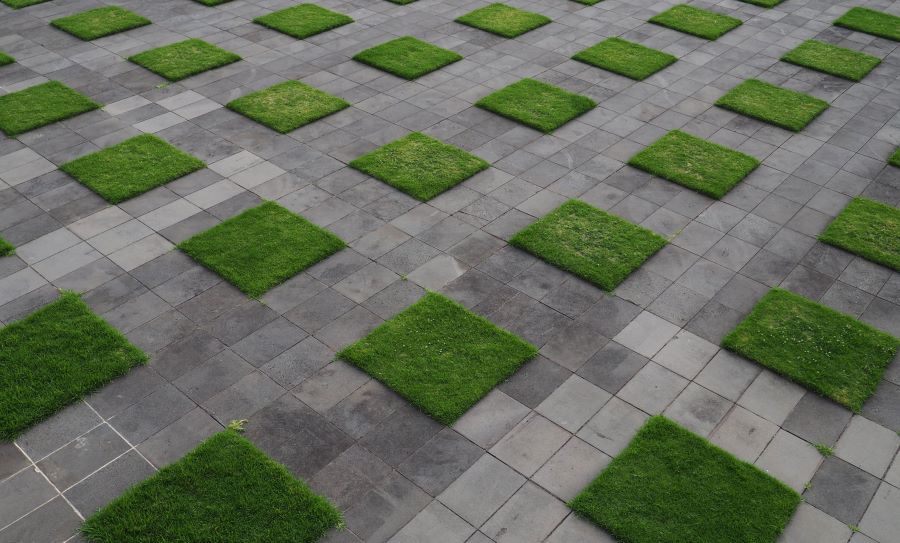Tips on How to Install Artificial Grass on Concrete


Are you tired of staring at that stark concrete slab in your yard?
The magic of artificial grass can make this a reality. You can convert your dull concrete into a vibrant, inviting, and low-maintenance green space in a few simple steps. It may sound like a big project, but you can easily handle it with the right tools and guidance.
This comprehensive guide will show you how to install artificial grass on concrete.
Installing artificial turf on concrete is a great way to enhance the look and functionality of your outdoor space. One of the key benefits is that it offers a clean, uniform appearance with minimal maintenance. Artificial grass on concrete is perfect for areas where natural grass doesn’t grow well, saving you from the hassle of watering, mowing, and fertilizing.
However, learning how to install artificial grass on concrete comes with its own set of challenges. Firstly, the surface must be smooth and level to prevent unevenness in the turf. Secondly, proper drainage must be accounted for, as improper drainage can lead to pooling and damage. Yet, these challenges can be effectively managed with the right preparation and tools.
Before embarking on your project of how to lay artificial grass on concrete, some pre-installation preparation is needed. This phase is critical to ensure a seamless installation and flawless final look.
Start by measuring the area where you intend to install the artificial turf. Use a tape measure to determine the length and width of the surface. It’s crucial to have accurate measurements as they will guide you in purchasing the right amount of artificial turf and other materials.
Once you have your measurements, the next step is to gather the tools and materials necessary for the installation.
Several vital tools will come in handy during the installation process. These include:
In addition to the tools, several materials are necessary for the installation. These include:
When learning how to install artificial grass on concrete, consider drainage. Without proper drainage, water can pool on the surface of your turf, potentially leading to mold and mildew.
A slight slope of the concrete area will naturally guide water away. You should install a drainage layer if the area is flat. This consists of a layer of gravel or crushed rock underneath the turf to assist with water drainage.
Installing artificial grass on concrete can transform your outdoor space into a lush, green, and maintenance-free area. Let’s take a step-by-step look at the process.
Before you embark on the task of laying artificial grass on concrete, ensure the surface is clean. Remove any debris, dirt, or loose pieces of concrete that might interfere with the smoothness of the installation. You can use a stiff-bristle broom or a power washer to clean the area thoroughly.
Creating appropriate drainage is crucial when learning about artificial grass installation. While concrete does not naturally absorb water, your artificial turf must drain to prevent pooling.
To solve this, you can drill drainage holes into the concrete. Space the holes about 2-3 feet apart to ensure even drainage throughout the turf. Remember to wear appropriate safety gear, including safety glasses and gloves, when using power tools.
Installing a foam underlay is the next step in your artificial grass on the concrete project. This foam layer helps to provide cushioning, making the artificial grass feel more like natural grass underfoot.
Roll out the underlay across your concrete surface, ensuring it covers the area entirely. Cut it to fit using a utility knife, then secure it using outdoor-grade adhesive.
Once your underlay is in place, the next step is to apply adhesive to the concrete. Spread the adhesive evenly across the underlay using an adhesive spreader, ensuring all parts are coated.
Remember, patience is critical when figuring out how to lay artificial grass on concrete. Allow the adhesive to become tacky before moving on to the next step, which usually takes around 15 minutes.
After the adhesive becomes tacky, it’s time to roll out your artificial turf. Start from one end of the space, unrolling the turf carefully over the adhesive-coated underlay. Make sure there are no wrinkles or bubbles as you go.
Trim the edges of the artificial turf to fit your space using a utility knife. Ensure the knife is sharp enough to give clean cuts, avoiding fraying edges.
If your area requires more than one piece of turf, you must prepare joints. Place two pieces together, ensuring the grass blades point in the same direction, and cut the edges to create a neat seam.
To secure the artificial grass on concrete, apply artificial grass glue along the edges of the turf, then press firmly down. You can also use spikes or 40 D 5” nails for additional support, especially if your space experiences heavy foot traffic. Ensure the nails or spikes do not protrude above the grass to prevent tripping hazards and maintain an even look.
Applying the artificial grass infill is the final step in understanding how to install artificial grass on concrete. This process helps to weigh the grass down and keep the blades standing upright for a more natural look.
Spread the infill evenly across the turf, then use a stiff-bristled broom to brush the grass, encouraging the silica sand for artificial grass to settle at the base of the grass blades.
To sum up, installing artificial turf on concrete is relatively straightforward with the proper preparation and steps. The result is a stunning, low-maintenance lawn that brings a touch of greenery to your space all year round.

Festival Turf
Phone: 844-702-8873
Email: [email protected]
Las Vegas HQ Hours
Monday-Friday: 8:00am – 4:00pm PST
Saturday: 8:00am – 12:00pm
Sunday: CLOSED
Have a Question?
Contact us now and we’ll help you find what you need!

 10 Front Yard Landscaping Ideas with Rocks and Mulch
10 Front Yard Landscaping Ideas with Rocks and Mulch